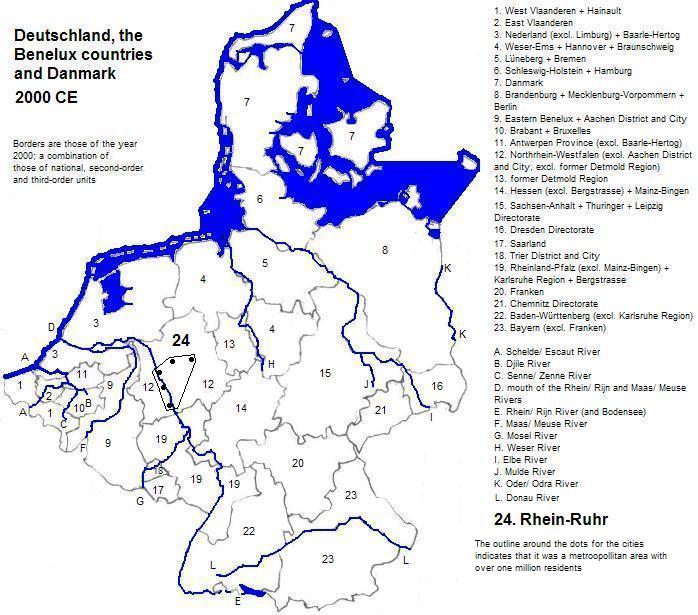Rhein-Ruhr
The Rhein-Ruhr metropolitan area of Deutschland1 has 11.8 million residents and is centered on four cities: Köln (Cologne in English and French), Essen, Dortmund and Düsseldorf, none of which, in 2007, exceeded a million people. Other cities are Bochum, Duisburg, Mönchengladbach (formerly München-Gladbach), Wuppertal, Bonn and Brühl. Essen is on the right bank of the Ruhr; Düsseldorf on the Rhein,2 upstream from its confluence with the Ruhr; and Köln,3 yet further upstream, and on the opposite, left, bank from Düsseldorf. The northern part of the region, always including Essen and Duisburg, sometimes including Dortmund, is often called the Ruhr. Köln's Cathedral4, a World Heritage Site, is 157 meters high and claims to house relics of the three magi who were said to visit the infant, Jesus and 14th century stained glass windows. Also of note is the city's slightly shorter, modern Köln Tower;5 the Hansa-Hochhaus, finished in 1925, which was, for a time, Europe's, tallest commercial building; and the Messeturm, the cylindrical tower within within the Köln convention center. Essen has turned what was the largest coal mine in the world into a museum, which has been honored as a World Heritage Site (Zollverein Coal Mine Industrial Complex). That city also has the rebuilt Old Synagogue,6 said to be the largest north of the Alps; and the 127 meter tall RWE Tower.7 Two of Düsseldorf's notable buildings are the Rhein Tower,8 and the Colorium, with its “diving board” projecting roof. Dortmund's tallest structure is the Fernmeldeturm, a telecomm tower (220 meters). Bochum has a mining museum (the Deutsches Bergbaumuseum) that is topped with a pithead tower. Wuppertal is home of the world's first hanging monorail (Einschienige Hängebahn System Eugen Langen). Bonn's tallest building is the Post Tower (163 meters), a flattened cylinder. Between Köln and Bonn is Brühl, site of the 18th century palace of Augustusburg and hunting lodge of Falkenlust. The palace is famed for a lavish staircase created by Balthasar Neumann, and the two buildings are connected by formal gardens. Together they constitute a World Heritage Site. At the east end of the metropolitan area are ruins from the Saxon and Carolingian eras: Hohensburg. Other area attractions are the Klutert Cave.
| City or metropolitan area | Year | Population9 | Political entity |
| Köln | 1200 | 50,000 | Imperium Romanum Sacrum (Holy Roman Empire) |
| Köln | 1300 | 52,000 | Köln Reichsstadt10 (nominally part of the Imperium Romanum Sacrum or Holy Roman Empire) |
| Köln | 1400 | 40,000 | Köln Reichsstadt10 (nominally part of the Imperium Romanum Sacrum or Holy Roman Empire) |
| Köln | 1500 | 38,000 | Köln Reichsstadt (nominally part of the Imperium Romanum Sacrum or Holy Roman Empire) |
| Köln | 1600 | 37,000 | Köln Reichsstadt (nominally part of the Imperium Romanum Sacrum or Holy Roman Empire) |
| Köln | 1700 | 37,000 | Köln Reichsstadt (nominally part of the Imperium Romanum Sacrum or Holy Roman Empire) |
| Cologne | 1800 | 41,000 | République française (French Republic) |
| Köln | 1900 | 437,000 | Deutsches Reich (German Empire) |

Historical maps
-DuesseldorfR-ArnsbergR-MuensterR_map_1200_ce.jpg)
-DuesseldorfR-ArnsbergR-MuensterR_map_1300_ce.jpg)
-DuesseldorfR-ArnsbergR-MuensterR_map_1400_and_1500_ce.jpg)
-DuesseldorfR-ArnsbergR-MuensterR_map_1600_ce.jpg)
-DuesseldorfR-ArnsbergR-MuensterR_map_1700_ce.jpg)
-DuesseldorfR-ArnsbergR-MuensterR_map_1800_ce.jpg)
-DuesseldorfR-ArnsbergR-MuensterR_map_1900_ce.jpg)

Footnotes
1. Germany in English.
2. Rhine in English.
3. Cologne in French and English.
4. Formally and in German, the Hohe Domkirche St. Peter und Maria.
5. Köln Turm in German.
6. Alte Synagoge in German.
7. RWE-Turm in German.
8. Rheinturm in German.
9. Estimates in Tables of the World's Largest Cities, or in Continental Tables and Maps: Europe, both in Tertius Chandler, Four Thousand Years of Urban Growth, 2nd ed. (The Edwin Mellen Press, 1987). In 1200 and 1300 Köln was the largest city in what is now Deutschland, België, Nederland, Luxembourg and Danmark.
10. Free state (Reichsstadt) status not yet confirmed.


-DuesseldorfR-ArnsbergR-MuensterR_map_1200_ce.jpg)
-DuesseldorfR-ArnsbergR-MuensterR_map_1300_ce.jpg)
-DuesseldorfR-ArnsbergR-MuensterR_map_1400_and_1500_ce.jpg)
-DuesseldorfR-ArnsbergR-MuensterR_map_1600_ce.jpg)
-DuesseldorfR-ArnsbergR-MuensterR_map_1700_ce.jpg)
-DuesseldorfR-ArnsbergR-MuensterR_map_1800_ce.jpg)
-DuesseldorfR-ArnsbergR-MuensterR_map_1900_ce.jpg)
